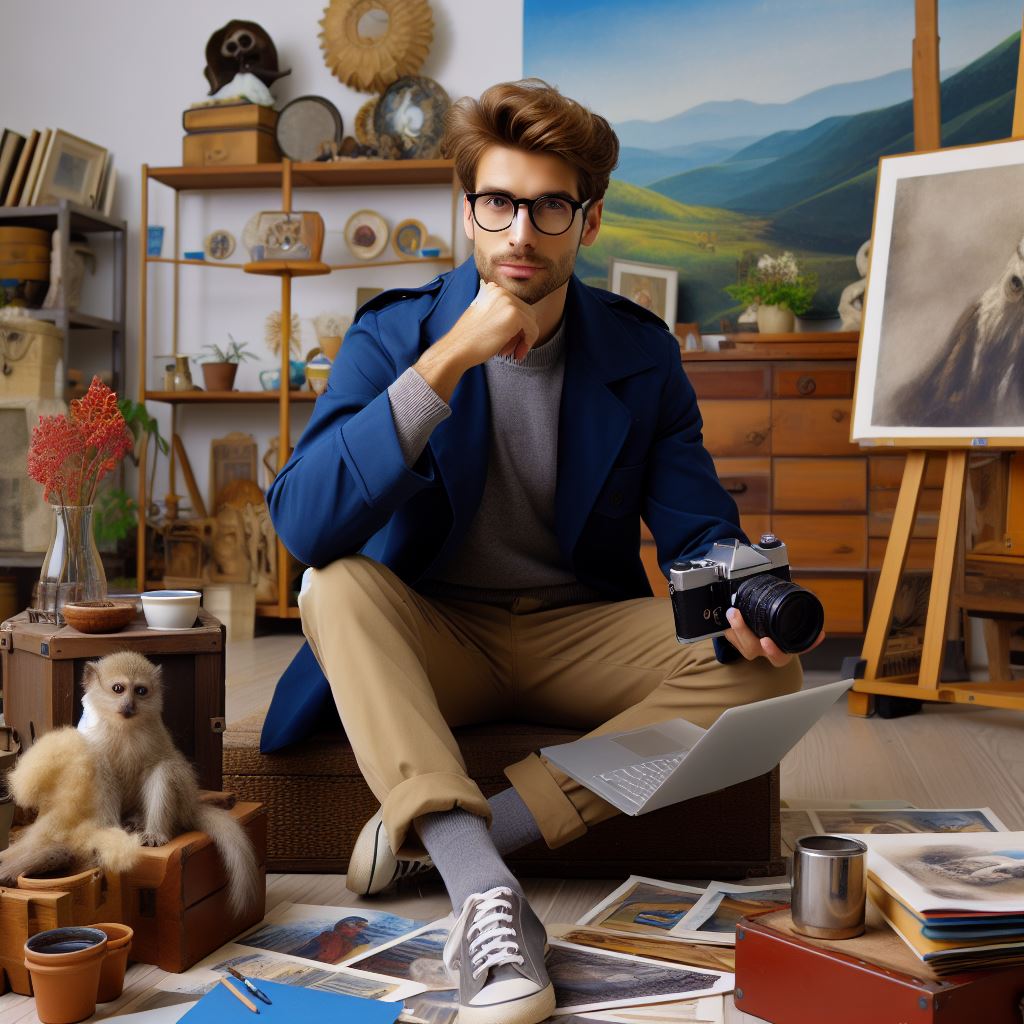Introduction
Art curatorship in New Zealand is a multifaceted and vibrant field that serves as the backbone of the country’s artistic ecosystem.
Curators, often unsung heroes of the art world, play an indispensable role in preserving, interpreting, and presenting artworks to the public.
Their responsibilities extend far beyond arranging pieces in a gallery; they act as custodians of culture, historians, and facilitators of artistic dialogue.
The importance of art curators cannot be overstated. They serve as bridges between artists and audiences, fostering meaningful connections and dialogue.
Through their expertise and vision, curators curate exhibitions that engage, educate, and inspire visitors. They navigate the complexities of the art market, ensuring that artworks are ethically acquired and displayed.
Moreover, curators contribute to the preservation of cultural heritage, safeguarding artworks for future generations.
In this blog post, we embark on a journey into the world of art curatorship in New Zealand.
We will explore the vital role of curators, their impact on the art industry, and the significance of their work in shaping cultural narratives.
Whether you’re an aspiring curator, a seasoned art enthusiast, or simply curious about the inner workings of the art world, this post aims to provide comprehensive insights into the dynamic realm of art curation in New Zealand.
Overview of Art Curatorship
Art curatorship is the practice of managing and overseeing art collections and exhibitions.
Art curators are responsible for various tasks, including selecting artworks, preserving their integrity, and organizing exhibitions.
Curators play a crucial role in the art world, bridging the gap between artists, artworks, and the audience.
Defining the Concept of Art Curatorship
Art curatorship involves the curation, management, and presentation of art collections in galleries or museums.
Curators aim to create meaningful and engaging exhibitions that educate and inspire viewers.
They curate exhibitions by carefully selecting artworks that fit a specific theme or concept.
Responsibilities and Duties of Art Curators
- Art curators research and explore various artists and artistic movements to identify potential artworks for exhibitions.
- They negotiate the acquisition or loaning of artworks with artists, collectors, or other institutions.
- Curators also collaborate with exhibition designers to determine the artwork placement and create visually appealing displays.
- They handle artworks with care, ensuring their preservation through proper storage, handling, and climate control measures.
- Curators often write exhibition catalogs and wall texts to provide contextual information about the artworks.
Art Curatorship: Crafting Engaging Exhibitions
Selecting, Preserving, and Displaying Artworks
Curators follow a meticulous process when selecting artworks for an exhibition.
They consider various factors, such as the artwork’s relevance to the theme, artistic quality, and historical significance.
Once selected, curators ensure proper preservation by implementing appropriate conservation techniques.
Curators collaborate with conservators to repair and maintain artworks, ensuring their longevity.
Personalized Career Consulting
Unlock your potential with expert career advice tailored to your goals. Get personalized guidance and actionable steps toward your dream career in New Zealand.
Get StartedWhen displaying artworks, curators strive to create a cohesive and engaging narrative within the exhibition space.
They arrange artworks in a way that enhances their visual impact and encourages viewers to explore the exhibition.
Curators consider lighting, spatial relationships, and audience accessibility during the display process.
To captivate the audience, curators may also incorporate interactive elements or multimedia installations.
In essence, art curatorship is a multifaceted practice that involves the management and presentation of art collections.
Curators play a crucial role in creating thought-provoking exhibitions that educate, inspire, and preserve artistic heritage.
Through their careful selection, preservation, and display of artworks, curators connect artists’ visions with the audience’s experience.
Read: NZ Artists’ Paths: Education to Success
History of Art Curatorship in New Zealand
In order to understand the current state of art curatorship in New Zealand, it is important to explore its historical development and key milestones.
This section provides a brief background on the emergence of art curatorship in the country, highlights significant moments, and discusses the establishment of art galleries and museums.
Emergence of Art Curatorship in New Zealand
- The origins of art curatorship in New Zealand can be traced back to the late 19th century.
- As European settlers arrived in the country, they brought with them their art collections and the concept of curating.
- Initially, art curatorship was primarily focused on private collections and displayed in personal homes.
- However, as the appreciation and demand for art grew, the need for public galleries and museums became apparent.
Key Moments and Milestones
- One of the key milestones in the history of art curatorship in New Zealand was the establishment of the Auckland Art Gallery in 1888.
- It was the first public art gallery in the country, marking a significant turning point in the accessibility of art for the general public.
- Another important moment was the establishment of the National Art Gallery in Wellington in 1936.
- It aimed to collect and exhibit artworks that represented New Zealand’s cultural identity and heritage.
- The establishment of the Museum of New Zealand Te Papa Tongarewa in 1998 was also a significant event.
- Te Papa, as it is commonly known, combines art, history, and culture, showcasing a diverse range of collections.
Establishment of Art Galleries and Museums
- Alongside the aforementioned key milestones, numerous art galleries and museums were founded throughout New Zealand.
- These institutions play a crucial role in the preservation, display, and interpretation of art and cultural artifacts.
- One example is the Christchurch Art Gallery, established in 2003, which houses an extensive collection of both national and international art.
- Additionally, numerous regional art galleries and museums have emerged in cities such as Dunedin, Hamilton, and Wellington.
- These institutions contribute significantly to the promotion and celebration of New Zealand’s artistic expressions.
In general, the history of art curatorship in New Zealand showcases the development of public galleries and museums, marking milestones in the accessibility and appreciation of art.
From humble beginnings in private collections, the establishment of institutions like the Auckland Art Gallery and Te Papa revolutionized the way art is experienced in the country.
Today, through an extensive network of galleries and museums, New Zealand continues to enrich its cultural landscape through the curation and exhibition of art.
Read: Grants for NZ Musicians: A Guide
Key Art Curators in New Zealand
New Zealand’s art scene has been greatly influenced and shaped by the contributions of several notable art curators.
These individuals have not only curated exceptional exhibitions but also played a vital role in promoting and nurturing the country’s artistic talent.
Justin Paton
- Justin Paton is a highly regarded art curator who has had a significant impact on New Zealand’s art scene.
- With a background in art history, Paton has curated numerous acclaimed exhibitions both in New Zealand and internationally.
- He is known for his ability to bring together diverse artworks and create meaningful connections within exhibitions.
- Paton’s work has influenced how New Zealand art is perceived globally, emphasizing the unique cultural identity of the nation.
Rhana Devenport
- Rhana Devenport is an esteemed art curator who has made significant contributions to the contemporary art scene in New Zealand.
- With an extensive background in arts administration, Devenport has held important positions in several prominent New Zealand art institutions.
- She is known for her promotion of experimental and innovative art practices, often challenging traditional exhibition formats.
- Devenport’s work has not only showcased the talents of New Zealand artists but also fostered collaborations with international artists, enriching the art community.
Gregory O’Brien
- Gregory O’Brien is a highly respected art curator, writer, and poet who has played a significant role in New Zealand’s art scene.
- His diverse background in literature and visual arts brings a unique perspective to his curatorial work.
- O’Brien’s exhibitions often explore the intersections between literature and art, creating thought-provoking and multi-disciplinary experiences.
- His contributions have expanded the boundaries of the New Zealand art scene, showcasing the symbiotic relationship between various artistic disciplines.
Sarah Farrar
- Sarah Farrar is a prominent art curator known for her expertise in contemporary art and her contributions to New Zealand’s art landscape.
- With an academic background in art history, Farrar’s curatorial vision focuses on critical engagement and societal relevance.
- Her exhibitions often address pressing social and political issues, provoking conversations and raising awareness.
- Farrar’s work has been instrumental in making contemporary art accessible and engaging for a wider audience in New Zealand.
Linda Tyler
- Linda Tyler is a respected art curator, academic, and author who has made a lasting impact on New Zealand’s art community.
- With a background in art history and museum studies, Tyler’s expertise lies in curating historical and archival exhibitions.
- She has contributed to the preservation and showcasing of New Zealand’s artistic heritage, bringing attention to often overlooked periods and artists.
- Tyler’s work has enriched the understanding and appreciation of New Zealand’s art history, fostering a sense of cultural identity.
These key art curators in New Zealand have left an indelible mark on the country’s art scene.
Their expertise, innovative approaches, and passion for art have not only elevated the visibility of New Zealand artists but have also inspired future generations of curators and art enthusiasts.
Read: Women in NZ Music: Rising Stars
Transform Your Career with a Professional CV and Cover Letter
Stand out to employers with an ATS-optimized resume and tailored cover letter designed to match your dream role. Let us craft your job application materials for success!
Get StartedChallenges Faced by Art Curators in New Zealand
Art curators in New Zealand face unique challenges that can impact their ability to showcase the country’s art to the world.
These challenges range from limited resources and funding constraints to the complexities of cultural diversity.
Limited Resources
- Curators often have limited budgets, making it difficult to acquire and maintain art collections.
- The scarcity of resources may hinder the development of exhibitions, restricting the variety and scope of artworks.
- Small staffing teams create additional pressure on curators to multitask and fulfill various roles.
Funding Constraints
- Art institutions in New Zealand heavily rely on public funding, which can be unpredictable and susceptible to budget cuts.
- Securing private funding or sponsorships can be challenging, particularly for smaller galleries and emerging curators.
- The scarcity of financial resources limits the ability to host large-scale exhibitions or invest in promotional activities.
Cultural Diversity
- New Zealand has a multicultural society, resulting in a diverse range of artistic expressions and perspectives.
- Curators must navigate the complexities of cultural diversity and strive for inclusivity in their exhibitions.
- Ensuring representation of indigenous, minority, and underrepresented artists becomes a priority.
How Curators Navigate These Challenges and Showcase New Zealand’s Art
Despite these challenges, art curators in New Zealand find innovative ways to navigate them and promote the country’s art to the world. Here are some approaches they adopt:
Collaboration and Partnerships
Curators often collaborate with other art institutions, both locally and internationally, to share resources, expertise, and costs.
These collaborations help curators access new audiences and broaden the reach of their exhibitions.
Creative Fundraising Initiatives
Curators organize fundraising events, seek crowdfunding, or establish partnerships with businesses to secure additional funding for exhibitions and projects.
They also apply for grants and explore sponsorship opportunities to support their curatorial endeavors.
Community Engagement
Curators actively engage with the local community, working closely with artists, art organizations, and community groups.
They organize workshops, artist talks, and educational programs to raise awareness and create a sense of ownership and pride in the local art scene.
Digital Platforms and Virtual Exhibitions
Curators leverage online platforms and digital technologies to showcase New Zealand’s art to a global audience.
Virtual exhibitions, online collections, and social media campaigns allow art to be accessible to a wider audience, transcending geographical limitations.
Embracing Cultural Diversity
To overcome the challenges of cultural diversity, curators actively seek out artists from different backgrounds and perspectives.
They prioritize representation and recognition of indigenous, diverse, and underrepresented artists, ensuring a rich and inclusive art landscape.
Advocating for Increased Support
Curators advocate for increased government and public support for the arts, emphasizing its cultural and economic significance.
They raise awareness about the challenges they face, fostering a greater understanding of the importance of investment in the arts.
Essentially, art curators in New Zealand face challenges such as limited resources, funding constraints, and cultural diversity.
However, through collaboration, creative fundraising, community engagement, digital platforms, embracing cultural diversity, and advocacy, they navigate these challenges and continue to showcase New Zealand’s vibrant art scene to the world.
Read: NZ Music Festivals: Behind Scenes

Education and Training for Art Curators in New Zealand
Earning a profession in Art Curatorship in New Zealand requires both academic and professional qualifications.
Curators must possess a deep understanding of art history and a keen eye for selecting and presenting artwork.
Academic Qualifications
- Curators typically hold a bachelor’s degree in art history, museum studies, or a related field.
- Schools in New Zealand, such as the University of Auckland and Victoria University of Wellington, offer undergraduate programs in art history and museum studies.
- Postgraduate degrees, such as a Master’s in Art Curatorship, provide specialized knowledge and advanced training.
- These academic qualifications lay the foundation for curators to develop their expertise and gain a comprehensive understanding of the art world.
Professional Qualifications
- While academic qualifications are essential, professional experience is equally important for aspiring curators in New Zealand.
- Internships or practical experiences in museums, galleries, or art institutions allow curators to gain hands-on training.
- These opportunities provide exposure to diverse art collections, curatorial processes, and real-world challenges faced in the art industry.
- Relevant internships include the Auckland Art Gallery Toi o Tāmaki Internship Program and the Te Papa Museum Internship.
Educational Programs and Courses
- New Zealand offers a range of educational programs and courses that complement an aspiring curator’s academic qualifications.
- The University of Auckland provides a Master’s in Art Curatorship, focusing on curatorial practices and management.
- Museum and gallery studies courses at Victoria University of Wellington cover collection management, exhibition design, and art criticism.
- Short courses and workshops by institutions like the Auckland Museum cater to those seeking specific curatorial skills.
Enhancing Curatorial Skills
- Art curators in New Zealand can enhance their skills by attending conferences, seminars, and professional development opportunities.
- Organizations like Museums Aotearoa and The New Zealand Art Gallery Directors’ Association provide valuable networking opportunities.
- Curators can engage in research projects, collaborate with artists, and contribute to publications to further develop their expertise.
- Building a strong professional network is crucial for curators to stay updated with industry trends and cultivate partnerships.
Generally, pursuing a career in art curatorship in New Zealand requires a combination of academic qualifications and professional experiences.
The available educational programs, internships, and continuous professional development opportunities help curators develop the necessary skills and knowledge to succeed in the field.
Current Trends and Innovations in Art Curatorship
Art curatorship in New Zealand is witnessing exciting and transformative changes, with emerging trends and innovations reshaping the field.
This blog post explores the evolving landscape of art curatorship, focusing on the incorporation of technology, digital platforms, and recent events that showcase innovative curatorial approaches.
Boost Your Career with a Standout LinkedIn Profile
Attract recruiters and expand your network with a fully optimized LinkedIn profile tailored to highlight your strengths and professional goals. Let your profile open doors to new opportunities!
Get OptimizedIncorporation of Technology and Digital Platforms
Technology has revolutionized various aspects of our lives, and art curatorship is no exception.
Curators in New Zealand are increasingly leveraging digital platforms to enhance audience engagement and create immersive experiences.
Virtual reality (VR) and augmented reality (AR) technologies are being employed to transport viewers into the heart of an artwork, enabling a deeper understanding and connection.
Moreover, museums and galleries have started utilizing social media platforms to expand their reach and engage with a wider audience.
They can now share curated content, behind-the-scenes glimpses, and interactive experiences through platforms such as Instagram, Facebook, and YouTube.
One notable example of this digital integration is the Auckland Art Gallery Toi o Tāmaki, which launched an interactive mobile app.
Visitors can use the app to access additional information about artworks, audio guides, and virtual tours, enhancing their overall gallery experience.
Emerging Trends in Art Curatorship
A new trend in art curatorship is the emphasis on interdisciplinary collaborations and the merging of traditional and contemporary art practices.
Curators are seeking to break boundaries and create conversations by bringing together artists, scientists, historians, and other experts from different fields.
This interdisciplinary approach encourages the exchange of ideas, knowledge, and techniques, resulting in unique and thought-provoking exhibitions.
The blending of mediums, such as combining visual arts with music or performance, adds an immersive and dynamic element to the curator’s vision.
An example of this trend is the exhibition “Art meets Science” held at the Wellington City Gallery.
It brought together contemporary artists and scientists to explore the intersection of art and scientific concepts, creating an intellectually stimulating and visually captivating experience.
Recent Exhibitions and Events Showcasing Innovative Curatorial Approaches
In recent years, several exhibitions and events have demonstrated innovative curatorial approaches, pushing the boundaries of traditional exhibition practices.
One such event is the Auckland Art Fair, which provides a platform for both established and emerging artists to showcase their works.
The art fair creates an immersive environment, curating diverse artworks and facilitating direct interaction between artists and visitors.
This innovative approach not only promotes dialogue but also offers opportunities for art enthusiasts to discover new talent and expand their collections.
Another noteworthy exhibition is “Sensing Spaces: Architecture Reimagined” at the City Gallery in Wellington.
This interactive exhibition challenged the conventional understanding of architecture by transforming gallery spaces into immersive installations.
Through the integration of light, sound, and spatial design, visitors were invited to explore and experience architecture in a new and engaging way.
The exhibition showcased the power of curatorial innovation in transforming spaces and sparking dialogue about the built environment.
Art curatorship in New Zealand is at the forefront of embracing technology and exploring interdisciplinary collaborations.
The incorporation of digital platforms, such as VR and AR, along with the integration of social media, has revolutionized audience engagement.
Furthermore, recent exhibitions and events have showcased innovative curatorial approaches, breaking traditional boundaries and creating immersive experiences.
The evolving trends in art curatorship highlight the dynamic nature of the field in New Zealand, constantly pushing the boundaries to engage and inspire audiences.
Conclusion
In closing, art curatorship plays a vital role in the art scene of New Zealand. It ensures that the rich and diverse culture and heritage of the country are preserved and showcased to the world.
Curators are instrumental in promoting New Zealand’s art and culture by curating exhibitions, organizing public programs, and collaborating with artists.
They bring together various artistic expressions and facilitate meaningful dialogue between artists and audiences.
It is crucial to appreciate and support the work of art curators in New Zealand. Their dedication and expertise help in nurturing and sustaining the thriving art community in the country.
By attending exhibitions, purchasing artworks, and engaging with their programs, readers can actively contribute to the growth and recognition of New Zealand’s art scene.
Art curators are guardians of our cultural heritage, allowing us to connect with the past, appreciate the present, and envision the future.
Their contribution is invaluable, and it is our responsibility as viewers and patrons to acknowledge and support their endeavors.
Let us celebrate the passion and commitment of art curators in New Zealand and continue to be inspired by the beauty of their curated exhibitions.




